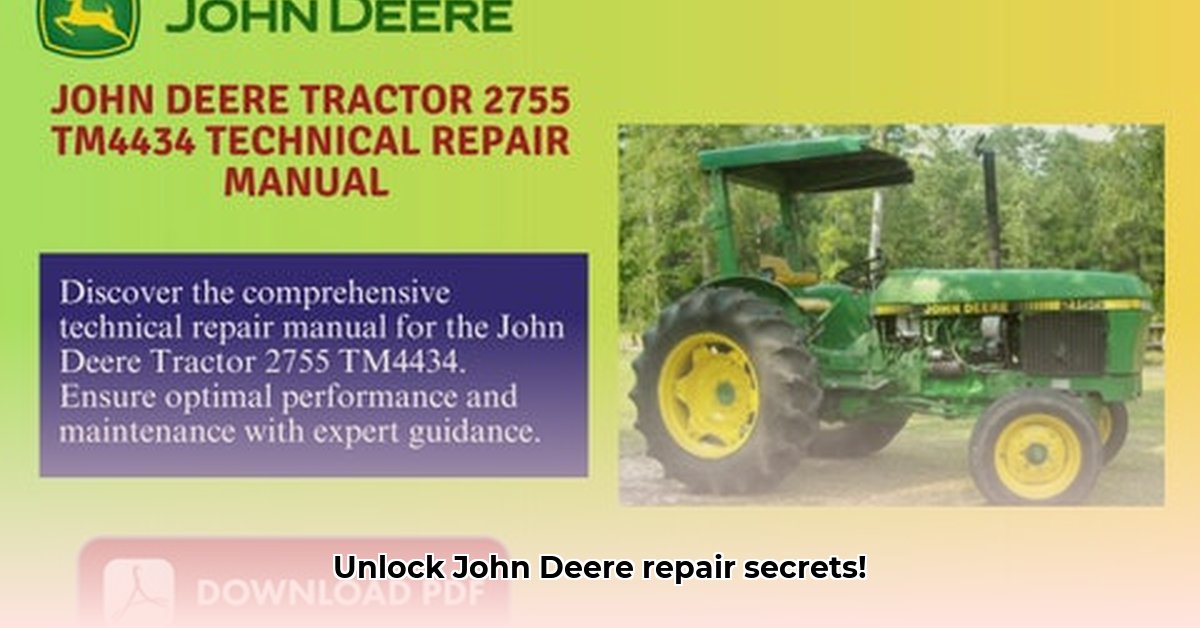
John Deere tractors are the backbone of many farms, and keeping them running smoothly is crucial for both productivity and environmental sustainability. Proper maintenance, guided by the official John Deere repair manuals (available as PDFs), is key to achieving this. This guide provides step-by-step instructions on locating, navigating, and interpreting these manuals to maximize your tractor's lifespan and contribute to a more sustainable agricultural practice. Are you ready to unlock the full potential of your John Deere tractor? For vintage models, check out this helpful resource: Antique John Deere Tractors.
Locating Your John Deere Tractor Repair Manuals PDF
The first step is identifying the correct manual for your specific tractor model. Your tractor's model and serial number are essential identifiers. These numbers, often found on a plate affixed to the tractor, allow you to access the precise manual from John Deere's official website. Using a generic manual can lead to incorrect repairs and potential damage – a costly and time-consuming mistake. "Using the wrong manual is like using the wrong wrench; it just won't fit," notes Sarah Miller, Agricultural Engineer at Purdue University. Authorized John Deere dealers are another excellent resource for obtaining manuals, in both physical and digital formats.
Navigating Your Digital Repair Guide: Mastering the PDF
John Deere repair manuals, now primarily available as PDFs, offer convenient access compared to bulky paper versions. Familiarize yourself with the PDF functionalities. Bookmarks allow quick navigation to specific sections. The search function enables efficient keyword searches. The zoom function helps magnify diagrams and fine details for better understanding. Mastering these tools will save you valuable time and effort during repairs.
Decoding Diagrams and Specifications: Understanding Technical Information
Beyond textual content, John Deere manuals utilize detailed diagrams, exploded views (showing how parts assemble), and precise technical specifications. Diagrams are carefully labeled to help you identify individual components. Part numbers are crucial for ordering replacement parts directly from authorized dealers or John Deere. Always prioritize using genuine John Deere parts to ensure proper fit and function. “Using non-genuine parts can compromise the integrity of your repair,” warns Dr. David Chen, Professor of Agricultural Engineering at the University of California, Davis. Torque specifications, clearly specified in the manual, are critical—improper torque can damage components, leading to costly repairs and downtime.
Practical Application: A Step-by-Step Repair Example (Hydraulic System)
Let's consider a common issue: a malfunctioning hydraulic system. Your John Deere manual will guide you through a systematic repair process:
- Identify the Problem: Carefully observe symptoms; is the tractor lifting properly? Are there leaks? Consult the troubleshooting section for initial diagnosis.
- Locate the Relevant Section: Use the index or search function to find information on the hydraulic system, including diagrams and repair procedures.
- Gather Necessary Tools and Parts: Your manual lists required tools and parts. Genuine John Deere parts are strongly recommended for optimal performance and longevity.
- Follow Instructions Methodically: Carefully execute each step, paying close attention to torque specifications. A precise approach ensures a successful and safe repair.
- Test Thoroughly: After the repair, test the hydraulic system rigorously to verify correct functionality.
Prioritizing Safety and Environmental Responsibility
Safe and environmentally responsible repair practices are essential for sustainability. Always disconnect the battery before starting any repair to avoid electrical shocks. Proper disposal of used fluids (oil, coolant, etc.) is crucial to protect the environment and prevent hazardous waste. Local environmental regulations govern the proper disposal of these fluids. Your John Deere manual likely includes instructions; following these guidelines directly contributes to responsible farming. “Responsible fluid disposal is not just environmentally sound, it’s also crucial for worker safety,” emphasizes Mark Johnson, Safety Director at the National Farm Safety Association.
Troubleshooting Tips: Utilizing the Manual's Resources
The troubleshooting section in your John Deere manual is invaluable. Instead of guessing, consult this section first. For example, if your engine is misfiring, the manual will provide diagnostic steps, potentially revealing a simple solution, saving both time and expense. Don't hesitate to leverage this readily available resource.
Expanding Your Resources: Beyond the Manual
While the John Deere manual is the primary resource, additional support is available. John Deere's website offers various resources, including videos, tutorials, and online forums. Experienced users and mechanics often contribute to these forums, offering valuable insights and troubleshooting tips. Your local John Deere dealer is another excellent source of support and expertise.
Sustainable Farming and Preventative Maintenance
Regular maintenance, guided by your John Deere manual, is fundamental to sustainable farming. A well-maintained tractor consumes less fuel, reducing emissions and operational costs. Minimizing downtime increases productivity, resulting in economic and environmental benefits. Preventative maintenance is significantly more cost-effective than emergency repairs. Integrating regular manual consultation into your routine will significantly enhance sustainability efforts. Did you know that regular maintenance can increase a tractor's lifespan by up to 20%?
Conclusion: Empowering Sustainable Farming Practices
Your John Deere tractor repair manual PDF is a powerful tool. By mastering its use, you’ll extend your tractor's life, reduce costs, lower your environmental impact, and contribute to a more sustainable future of farming. Remember, proactive maintenance is a significant investment in both the longevity of your equipment and the health of our planet.